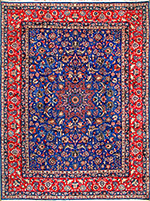Textiles Studies

Textile Research Works
Review of Bernard O'Kane, The Appearance of Persian on Islamic Art
Date of this Version
2012
Document Type
Article
Citation
Iranian Studies Vol. 45, No. 2, Special Issue: Pre-Islamic Iranian Literary Heritage (MARCH 2012), pp. 312-314
Abstract
Reviewed Work: The Appearance of Persian on Islamic Art (Biennial Ehsan Yarshater Lecture Series on Iranian Art and Archaeology, no. 4) Bernard O'Kane.
This study covers a broad geographic sweep, centered initially in Khorasan after the Arab conquests with the early patronage of Persian literature under the Samanids, an Iranian dynasty with Turkish governors, and the Ghaznavids, who took over rule in Ghazna to become a Turkish dynasty. O'Kane traces the emergence of the Persian language, first in texts such as the Shahnameh and in the titles of rulers, and the writing of history, and soon inscribed on ceramics and metalwork, and its early uses in writing on architecture in chapter 1, which covers the period roughly 950-1150. Chapter 2 considers Persian verses on lusterware ceramics and tilework, and metalwork, with monumental inscriptions on architecture still sparse in the period 1150-1350, while chapter 3 addresses the flourishing of monumental architectural inscriptions in Hindustan. Chapter 4 considers the Timurid and Safavid periods as the culmination of the appearance of Persian language; in the sixteenth century the number of surviving Persian inscriptions increased dramatically, with "the primacy of Persian finally established" (p. xiii). Overall the book addresses the visual appearance of Persian calligraphy, tracking developments chronologically and spatially from the middle of the seventh century through the sixteenth century. Throughout this stretch of time and space, many cultural ambiguities have to do with shifting identities, often in response to suc- cessive invasions and conquests, with language bending to accommodate political exigen- cies, commercial endeavors, and imagined cultural memories. The inquiring reader is richly rewarded in this little book, which reminds us of his- torically important connections among neighboring lands today divided into the bick- ering nation states of Pakistan, Kashmir, India, Bangladesh, that share a Persian literary heritage, as do Afghanistan, Uzbekistan, Tajikistan, Kyrgyzstan, Azerbaijan, Georgia, and Armenia, as well as the perhaps more obvious imperial connections among Turkey, Iran, and Turkmenistan.


Comments
Published by Cambridge University Press.
Links to review @ JSTOR